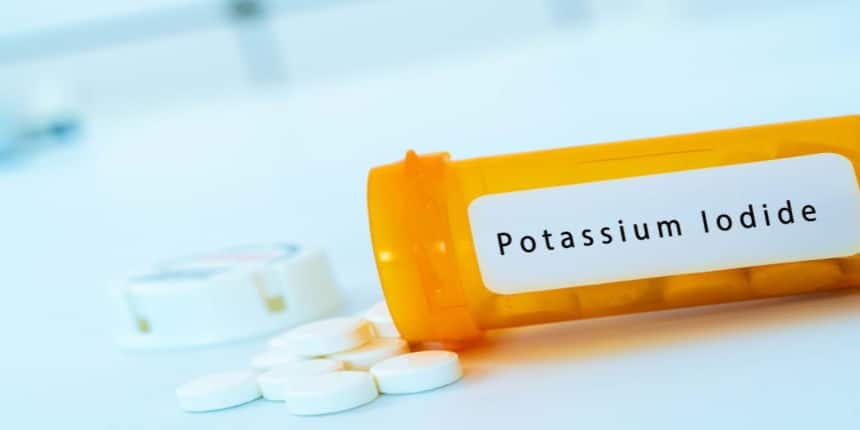KI Full Form
What is the Full Form of KL?
KI - Potassium Iodide
Potassium Iodide is a chemical compound that may also be used as a pharmaceutical and a food supplement. It is a medicine used to treat hyperthyroidism, and to protect the thyroid gland during radiation crises specific types of radiopharmaceuticals are administered, to treat cutaneous sporotrichosis and phycomycosis in the third world(countries that do not have access to basic medicines and hygiene). It is a dietary supplement for persons who have poor iodine consumption. It is given orally.
- What is the Full Form of KL?
- Food Supplement
- Protection Of The Thyroid Gland
- Adverse Consequences

The most common adverse effects include vomiting, diarrhoea, stomach discomfort, rash, and salivary gland enlargement.
Allergic reactions, headache, goitre, and depression are among the other adverse effects. While its usage during pregnancy may be harmful to the foetus, it is suggested in cases of radiation emergencies. The chemical formula of potassium iodide is . It is produced commercially by combining potassium hydroxide with iodine.
Food Supplement
Potassium iodide is a dietary supplement found in both animal feed and human food. It is the most often used addition in humans for "iodized" table salt (a public health measure to prevent iodine deficiency in populations that get little seafood). Iodide oxidation causes a steady loss of iodine content in iodised salts exposed to excess air. Over time and with exposure to extra oxygen and carbon dioxide, the alkali metal iodide salt progressively oxidises to metal carbonate and elemental iodine, which subsequently evaporates.
Potassium iodate is used to ionise certain salts, preventing iodine loss due to oxidation. Dextrose or sodium thiosulfate is frequently added to iodised table salt to stabilise potassium iodide, hence lowering its toxicity.
Protection Of The Thyroid Gland
Potassium iodide (KI) is a compound that can help to protect the thyroid gland from exposure to radioactive iodine. In the event of a nuclear accident or a nuclear explosion, the release of radioactive iodine into the atmosphere can be inhaled or ingested, leading to internal radiation exposure. If radioactive iodine is taken up by the thyroid gland, it can cause thyroid cancer and other health problems.
Taking potassium iodide can help to reduce the amount of radioactive iodine that is taken up by the thyroid gland. By saturating the thyroid gland with non-radioactive iodine, potassium iodide makes it less likely for radioactive iodine to be absorbed and accumulated in the thyroid. This can help to reduce the risk of thyroid cancer and other health problems.
It's important to note that potassium iodide is not a cure for all radiation exposure and it should not be used as a substitute for other protective measures such as evacuation or sheltering.
Adverse Consequences
High doses of potassium iodide and iodate should be avoided since they can create disorders such as the Jod-Basedow phenomenon, initiate and/or aggravate hyperthyroidism and hypothyroidism, and subsequently cause temporary or even permanent thyroid diseases. It can also induce sialadenitis (a salivary gland inflammation), gastrointestinal difficulties, and rashes. Potassium iodide is also not indicated for those who have dermatitis herpetiformis or hypocomplementemic vasculitis, both of which are associated with an increased risk of iodine sensitivity.
Frequently Asked Questions (FAQs)
Side effects of iodide used for medical purposes, at quantities 1000 times the typical nutritional demand, may include acne, lack of appetite, or upset stomach at maximum and occasionally considerably lower levels (especially during the first several days, as the body adjusts to the medication).
In the case of a radioiodine leak, prophylactic potassium iodide, or even iodate, would rightfully take precedence over perchlorate medication, and would be the first line of defence in safeguarding the population from a radioiodine release.
![]() is combined with silver nitrate to produce silver iodide (
is combined with silver nitrate to produce silver iodide (![]() ), a key component in film photography. Some disinfectants and hair care chemicals include
), a key component in film photography. Some disinfectants and hair care chemicals include ![]() . In biomedical research,
. In biomedical research, ![]() is also utilised as a fluorescence quenching agent, which takes use of the iodide ion's collisional quenching of luminous molecules. However, adding
is also utilised as a fluorescence quenching agent, which takes use of the iodide ion's collisional quenching of luminous molecules. However, adding ![]() at M-mM doses to numerous fluorophores increases fluorescence intensity, and iodide works as a fluorescence enhancer.
at M-mM doses to numerous fluorophores increases fluorescence intensity, and iodide works as a fluorescence enhancer.
Since at least 1820, potassium iodide has been utilised in medicine.